A pillar TOYOTA GT86 2017 1.G Owners Manual
[x] Cancel search | Manufacturer: TOYOTA, Model Year: 2017, Model line: GT86, Model: TOYOTA GT86 2017 1.GPages: 428, PDF Size: 7.83 MB
Page 71 of 428
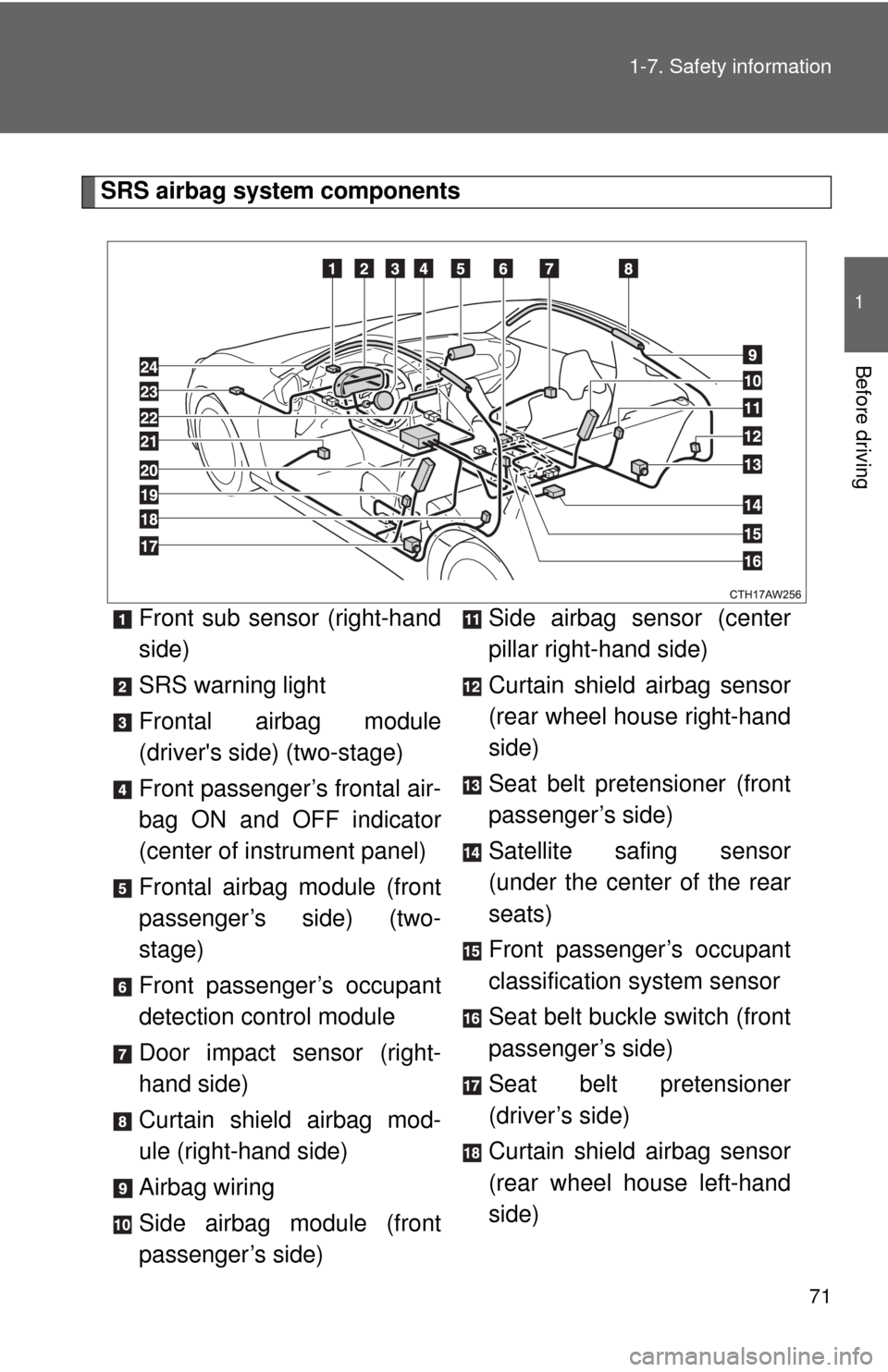
71
1-7. Safety information
1
Before driving
SRS airbag system components
Front sub sensor (right-hand
side)
SRS warning light
Frontal airbag module
(driver's side) (two-stage)
Front passenger’s frontal air-
bag ON and OFF indicator
(center of instrument panel)
Frontal airbag module (front
passenger’s side) (two-
stage)
Front passenger’s occupant
detection control module
Door impact sensor (right-
hand side)
Curtain shield airbag mod-
ule (right-hand side)
Airbag wiring
Side airbag module (front
passenger’s side) Side airbag sensor (center
pillar right-hand side)
Curtain shield airbag sensor
(rear wheel house right-hand
side)
Seat belt pretensioner (front
passenger’s side)
Satellite safing sensor
(under the center of the rear
seats)
Front passenger’s occupant
classification system sensor
Seat belt buckle switch (front
passenger’s side)
Seat belt pretensioner
(driver’s side)
Curtain shield airbag sensor
(rear wheel house left-hand
side)
Page 72 of 428

72 1-7. Safety information
Your vehicle is equipped with ADVANCED AIRBAGS designed based
on US motor vehicle safety standards (FMVSS208). The airbag sys-
tem controls airbag deployment power for the driver and front pas-
senger. The front passenger's airbag system consists of the front
passenger occupant detect ion control module etc.
The main SRS airbag system components are shown above. The
SRS airbag system is controlled by the airbag control module. The
airbag control module consists of an airbag sensor.
In certain types of severe front or side impacts, the SRS airbag sys-
tem triggers the airbag inflators. A chemical reaction in the inflators
quickly fills the airbags with non-toxic gas to help restrain the motion
of the occupants.
Side airbag sensor (center
pillar left-hand side)
Side airbag module (driver’s
side)
Door impact sensor (left-
hand side) Airbag control module
(including impact sensors
and rollover sensors)
Front sub sensor (left-hand
side)
Curtain shield airbag mod-
ule (left-hand side)
■
If the SRS airbags deploy (inflate)
●Slight abrasions, burns, bruising etc., may be sustained from SRS air-
bags, due to the extremely high speed deployment (inflation) by hot
gases.
● A loud noise and white powder will be emitted.
● Parts of the airbag module (steering wheel hub, airbag cover and inflator)
as well as the front seats, parts of the front and rear pillars, and roof side
rails, may be hot for several minutes. The airbag itself may also be hot.
● The windshield may crack.
Page 87 of 428

87
1-7. Safety information
1
Before driving
SRS side airbag and SRS curtain shield airbag
The SRS side airbag is stored in the door side of each front seat
seatback, which bears an “SRS AIRBAG” label.
In a moderate to severe side impact collision, the SRS side airbag on
the impacted side of the vehicle deploys between the occupant and
the door panel and supplements the seat belt by reducing the impact
on the occupant’s chest and waist. The SRS side airbag operates
only for front seat occupants.
The SRS curtain shield airbag on ea ch side of the cabin is stored in
the roof side (bet ween the front pillar and a poi nt over the rear seat).
An “SRS AIRBAG” mark is located at the top of each front and rear
pillar.
In a moderate to severe side impact collision, the SRS curtain shield
airbag on the impacted side of the vehicle deploys between the occu-
pant and the side window and supplements the seat belt by reducing
the impact on the occupant’s head.
Page 88 of 428

88 1-7. Safety information
■Operation
The SRS side airbag and SRS curtain shield airbag can function only when
the engine switch is in the “ON” position.
The driver’s and front passenger’s SRS side airbags and SRS curtain shield
airbags deploy independently of each other since each has its own impact
sensor. Therefore, they may not both deploy in the same accident. Also, the
SRS side airbag and SRS curtain shield airbag deploys independently of the
driver’s and front passenger’s SRS front airbags in the steering wheel and
instrument panel.
A rollover sensor is also located inside the airbag control module.
An impact sensor, which senses impact force, is located in each of the left
and right center pillars, doors and rear wheel houses. Another impact sen-
sor, which also senses impact force, is located under the center of the rear
seats.
If the impact sensor that is located under the center of the rear seats and
one of the center pillar impact sensors or door impact sensors together
sense an impact force above a predetermined level in a side collision, the
control module causes both the SRS side airbag and curtain shield airbag on
the impacted side to inflate regardless of whether the rear wheel house
impact sensor on the same side senses an impact.
If the impact sensor that is located under the center of the rear seats and
one of the rear wheel house impact sensors together sense an impact force
above a predetermined level, the control module causes only the SRS cur-
tain shield airbag on the impacted side to inflate.
If the rollover sensor detects rollover of the vehicle, the control module
inflates the SRS curtain shield airbags. At this time, the driver's and front
passenger’s seat belt pretensioners also operate at the same time.
Page 95 of 428
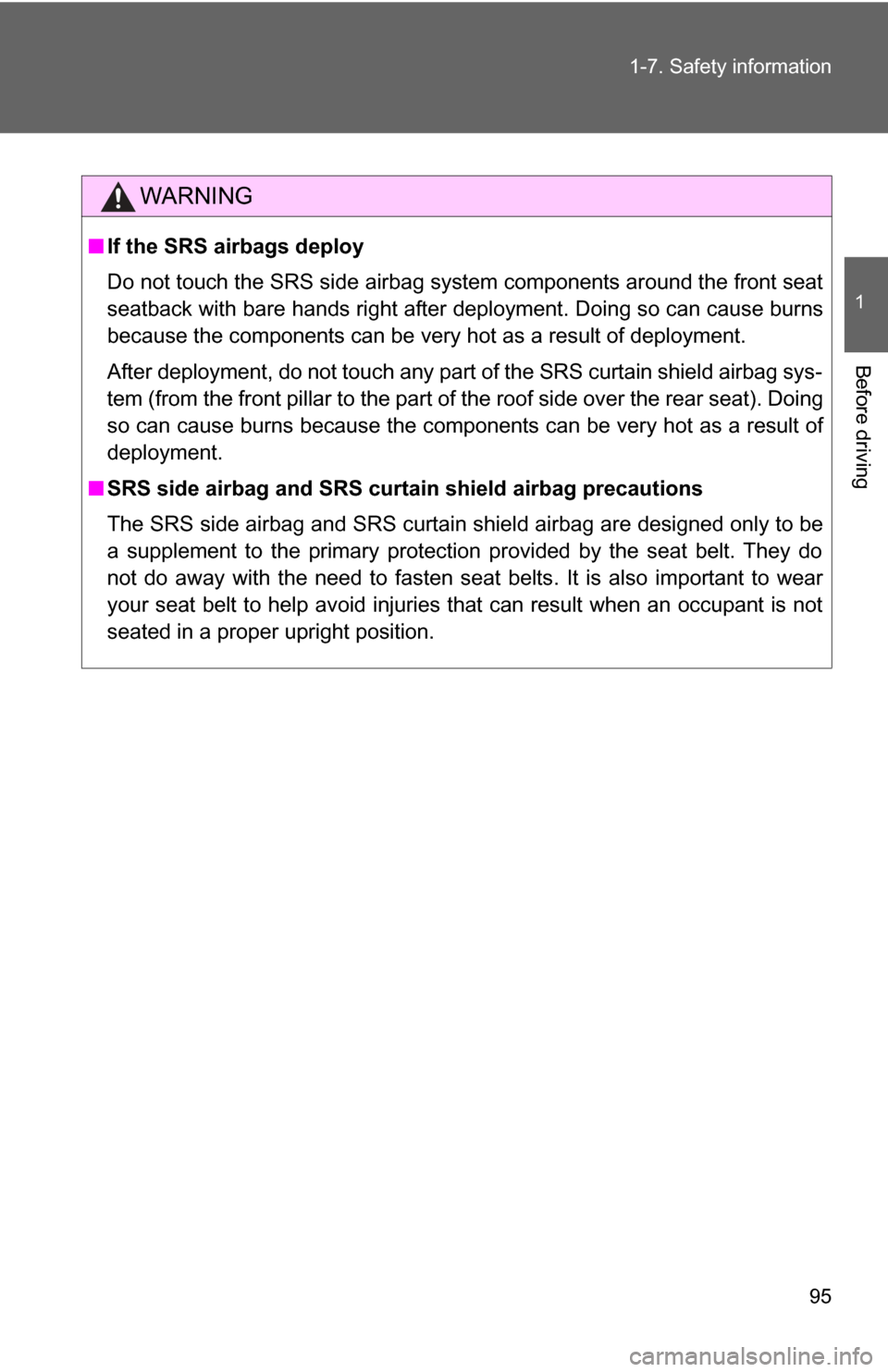
95
1-7. Safety information
1
Before driving
WARNING
■
If the SRS airbags deploy
Do not touch the SRS side airbag system components around the front seat
seatback with bare hands right after deployment. Doing so can cause burns
because the components can be very hot as a result of deployment.
After deployment, do not touch any part of the SRS curtain shield airbag sys-
tem (from the front pillar to the part of the roof side over the rear seat). Doing
so can cause burns because the components can be very hot as a result of
deployment.
■ SRS side airbag and SRS curtain shield airbag precautions
The SRS side airbag and SRS curtain shield airbag are designed only to be
a supplement to the primary protection provided by the seat belt. They do
not do away with the need to fasten seat belts. It is also important to wear
your seat belt to help avoid injuries that can result when an occupant is not
seated in a proper upright position.
Page 97 of 428
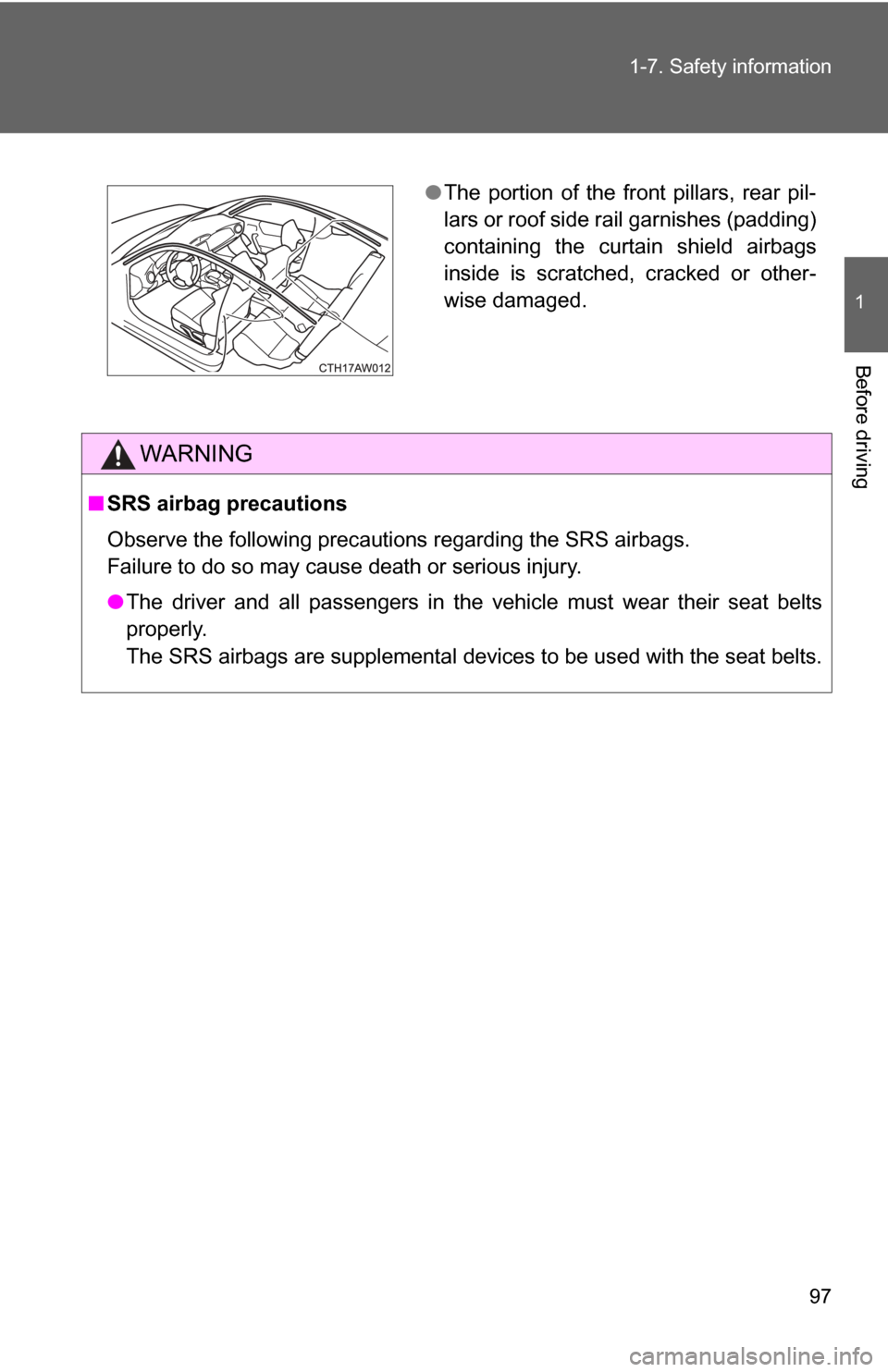
97
1-7. Safety information
1
Before driving
WARNING
■
SRS airbag precautions
Observe the following precautions regarding the SRS airbags.
Failure to do so may cause death or serious injury.
●The driver and all passengers in the vehicle must wear their seat belts
properly.
The SRS airbags are supplemental devices to be used with the seat belts.
●The portion of the front pillars, rear pil-
lars or roof side rail garnishes (padding)
containing the curtain shield airbags
inside is scratched, cracked or other-
wise damaged.
Page 100 of 428
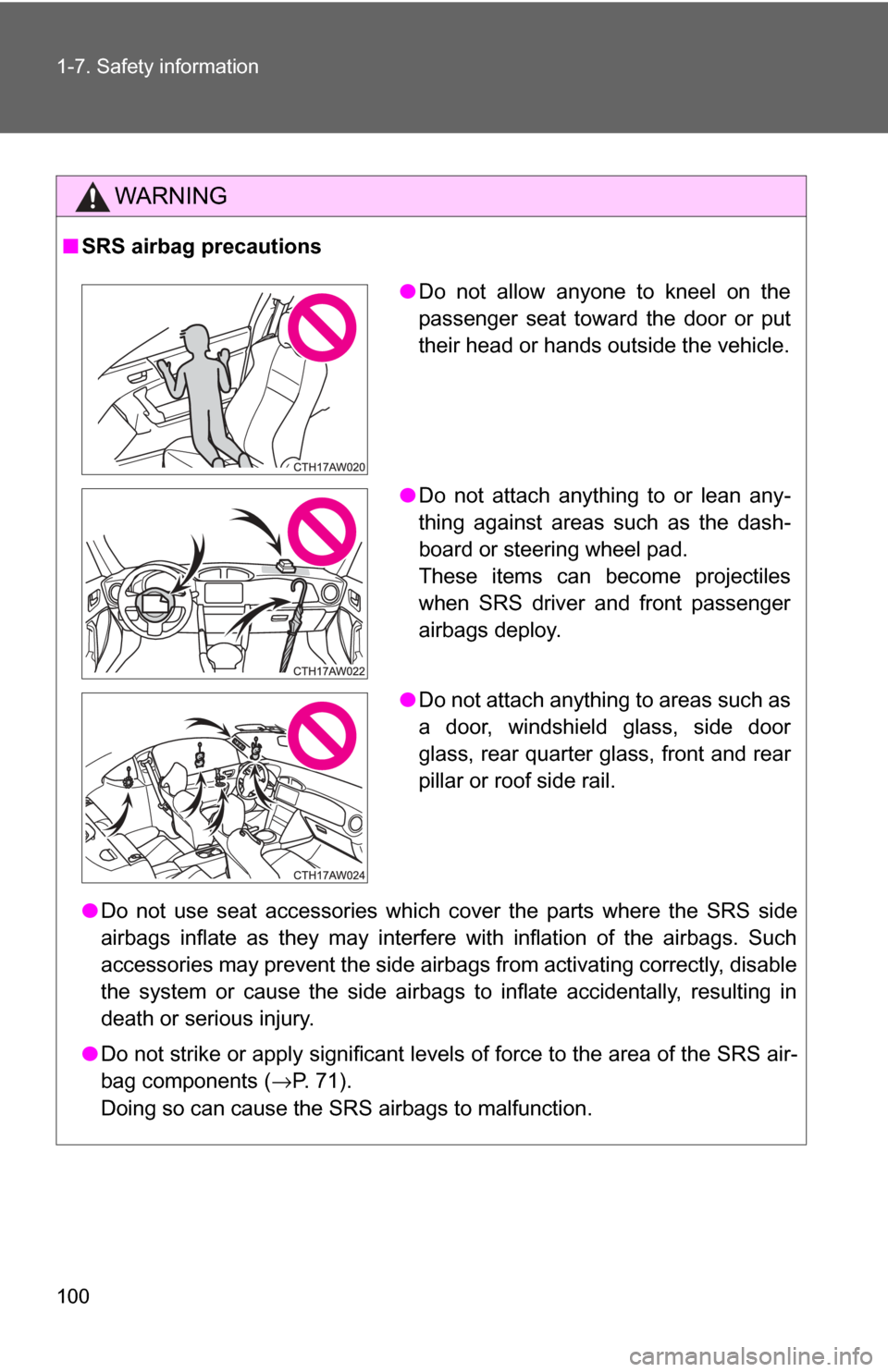
100 1-7. Safety information
WARNING
■SRS airbag precautions
●Do not use seat accessories which cover the parts where the SRS side
airbags inflate as they may interfere with inflation of the airbags. Such
accessories may prevent the side airbags from activating correctly, disable
the system or cause the side airbags to inflate accidentally, resulting in
death or serious injury.
● Do not strike or apply significant levels of force to the area of the SRS air-
bag components ( →P. 71).
Doing so can cause the SRS airbags to malfunction.
●Do not allow anyone to kneel on the
passenger seat toward the door or put
their head or hands outside the vehicle.
● Do not attach anything to or lean any-
thing against areas such as the dash-
board or steering wheel pad.
These items can become projectiles
when SRS driver and front passenger
airbags deploy.
● Do not attach anything to areas such as
a door, windshield glass, side door
glass, rear quarter glass, front and rear
pillar or roof side rail.
Page 101 of 428
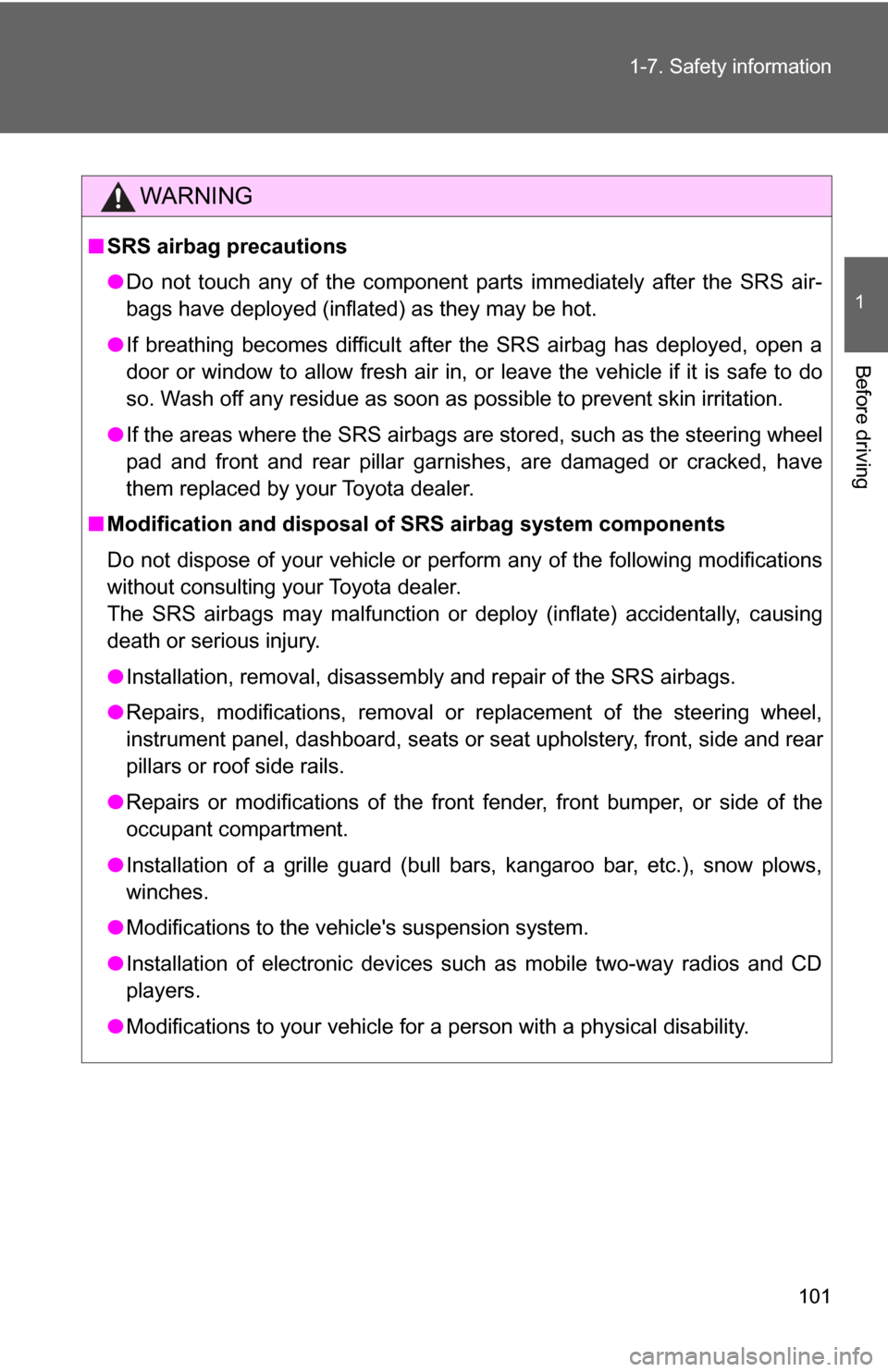
101
1-7. Safety information
1
Before driving
WARNING
■
SRS airbag precautions
●Do not touch any of the component parts immediately after the SRS air-
bags have deployed (inflated) as they may be hot.
● If breathing becomes difficult after the SRS airbag has deployed, open a
door or window to allow fresh air in, or leave the vehicle if it is safe to do
so. Wash off any residue as soon as possible to prevent skin irritation.
● If the areas where the SRS airbags are stored, such as the steering wheel
pad and front and rear pillar garnishes, are damaged or cracked, have
them replaced by your Toyota dealer.
■ Modification and disposal of SRS airbag system components
Do not dispose of your vehicle or perform any of the following modifications
without consulting your Toyota dealer.
The SRS airbags may malfunction or deploy (inflate) accidentally, causing
death or serious injury.
● Installation, removal, disassembly and repair of the SRS airbags.
● Repairs, modifications, removal or replacement of the steering wheel,
instrument panel, dashboard, seats or seat upholstery, front, side and rear
pillars or roof side rails.
● Repairs or modifications of the front fender, front bumper, or side of the
occupant compartment.
● Installation of a grille guard (bull bars, kangaroo bar, etc.), snow plows,
winches.
● Modifications to the vehicle's suspension system.
● Installation of electronic devices such as mobile two-way radios and CD
players.
● Modifications to your vehicle for a person with a physical disability.
Page 102 of 428
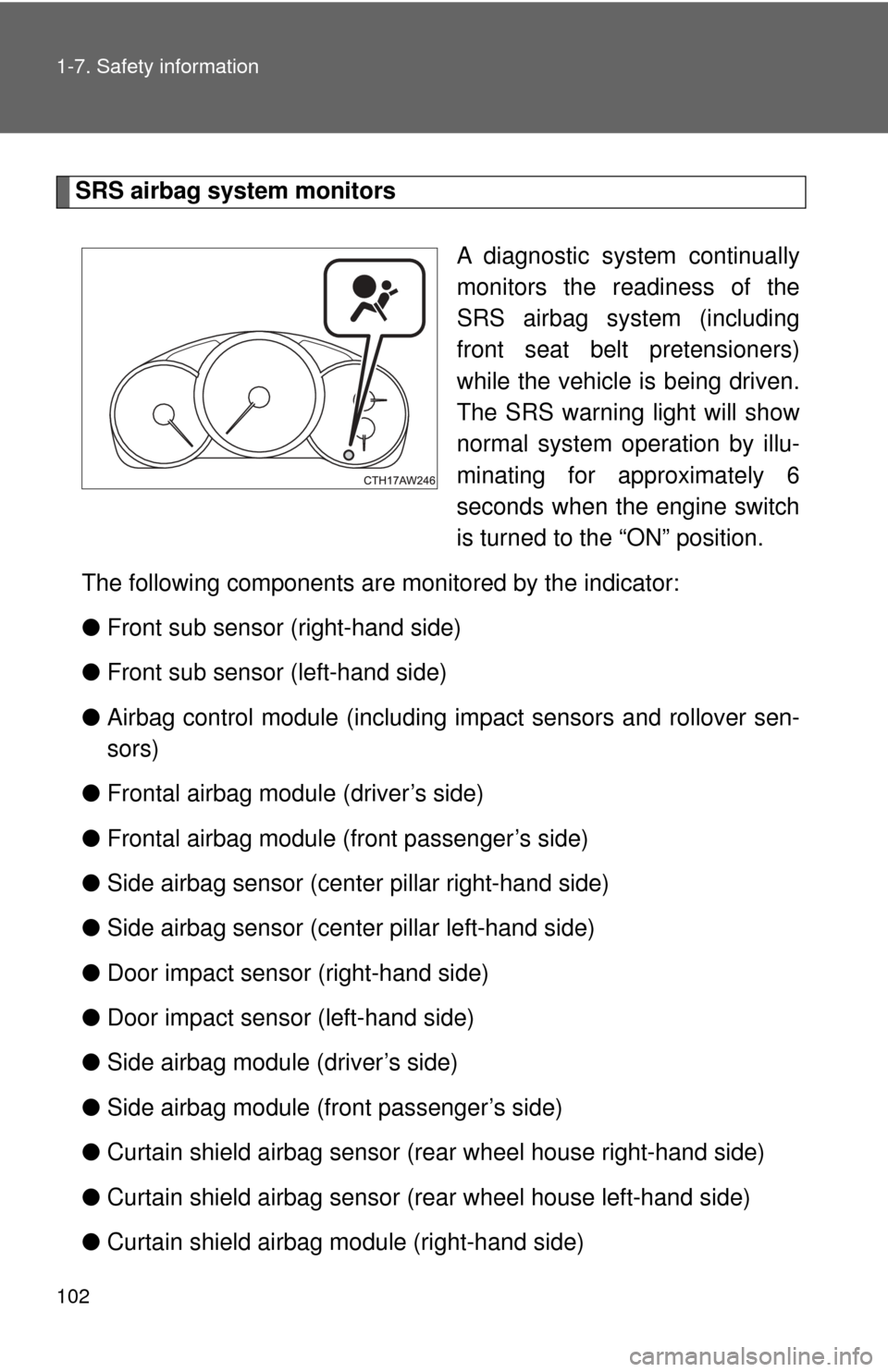
102 1-7. Safety information
SRS airbag system monitorsA diagnostic system continually
monitors the readiness of the
SRS airbag system (including
front seat belt pretensioners)
while the vehicle is being driven.
The SRS warning light will show
normal system operation by illu-
minating for approximately 6
seconds when the engine switch
is turned to the “ON” position.
The following components are monitored by the indicator:
● Front sub sensor (right-hand side)
● Front sub sensor (left-hand side)
● Airbag control module (including impact sensors and rollover sen-
sors)
● Frontal airbag module (driver’s side)
● Frontal airbag module (front passenger’s side)
● Side airbag sensor (center pillar right-hand side)
● Side airbag sensor (center pillar left-hand side)
● Door impact sensor (right-hand side)
● Door impact sensor (left-hand side)
● Side airbag module (driver’s side)
● Side airbag module (front passenger’s side)
● Curtain shield airbag sensor (rear wheel house right-hand side)
● Curtain shield airbag sensor (rear wheel house left-hand side)
● Curtain shield airbag module (right-hand side)
Page 115 of 428
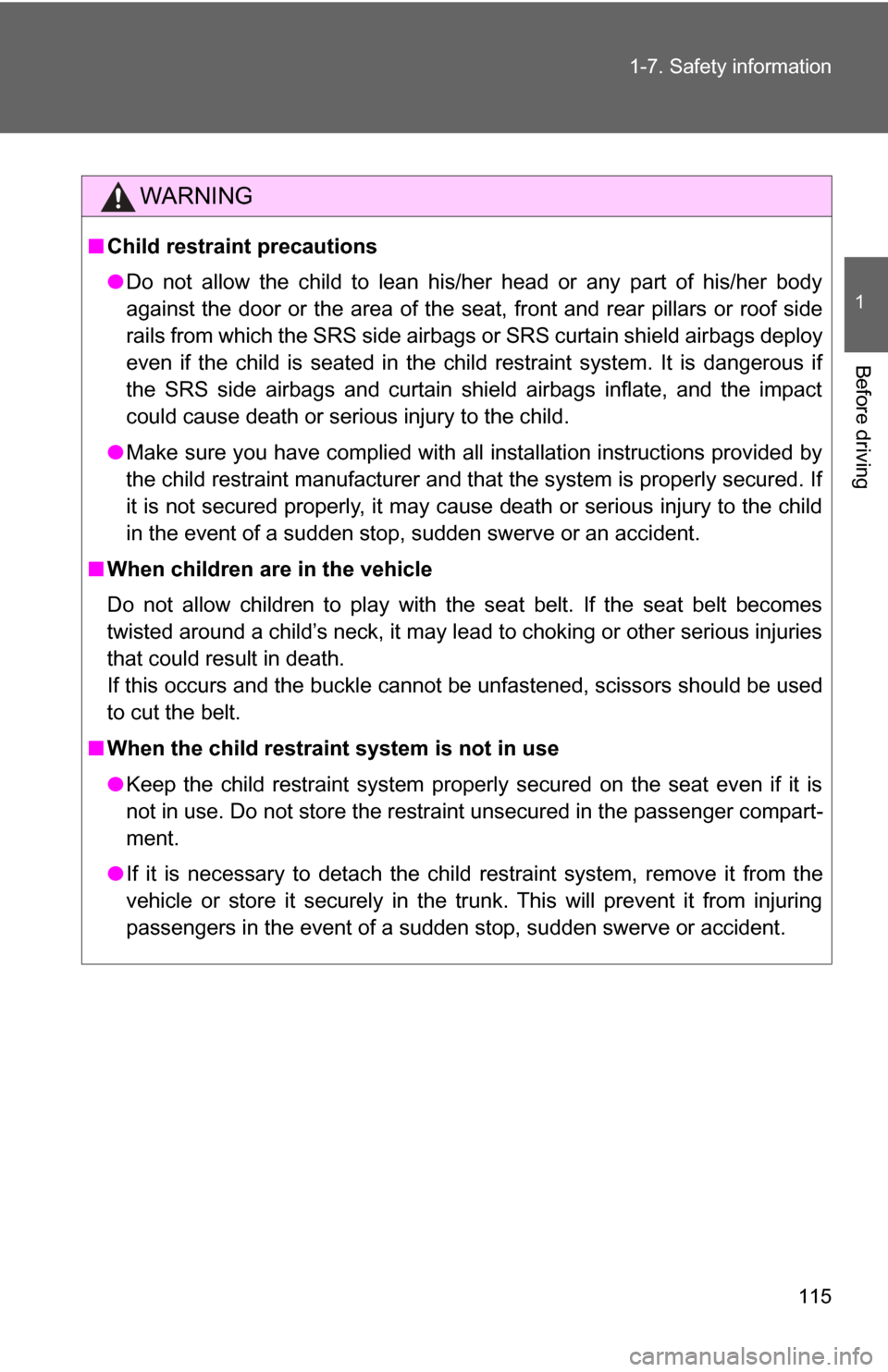
115
1-7. Safety information
1
Before driving
WARNING
■
Child restraint precautions
●Do not allow the child to lean his/her head or any part of his/her body
against the door or the area of the seat, front and rear pillars or roof side
rails from which the SRS side airbags or SRS curtain shield airbags deploy
even if the child is seated in the child restraint system. It is dangerous if
the SRS side airbags and curtain shield airbags inflate, and the impact
could cause death or serious injury to the child.
● Make sure you have complied with all installation instructions provided by
the child restraint manufacturer and that the system is properly secured. If
it is not secured properly, it may cause death or serious injury to the child
in the event of a sudden stop, sudden swerve or an accident.
■ When children are in the vehicle
Do not allow children to play with the seat belt. If the seat belt becomes
twisted around a child’s neck, it may lead to choking or other serious injuries
that could result in death.
If this occurs and the buckle cannot be unfastened, scissors should be used
to cut the belt.
■ When the child restraint system is not in use
●Keep the child restraint system properly secured on the seat even if it is
not in use. Do not store the restraint unsecured in the passenger compart-
ment.
● If it is necessary to detach the child restraint system, remove it from the
vehicle or store it securely in the trunk. This will prevent it from injuring
passengers in the event of a sudden stop, sudden swerve or accident.